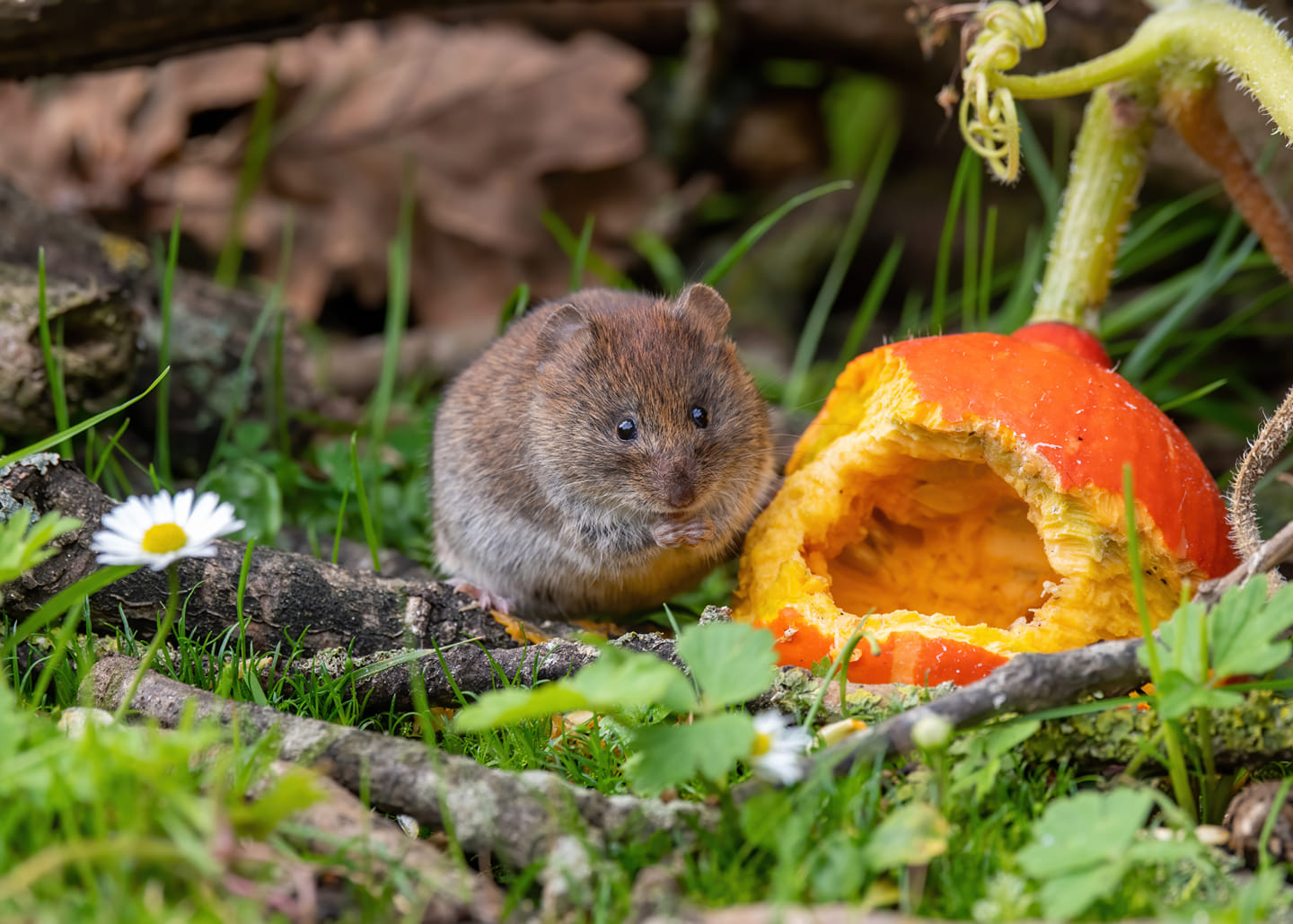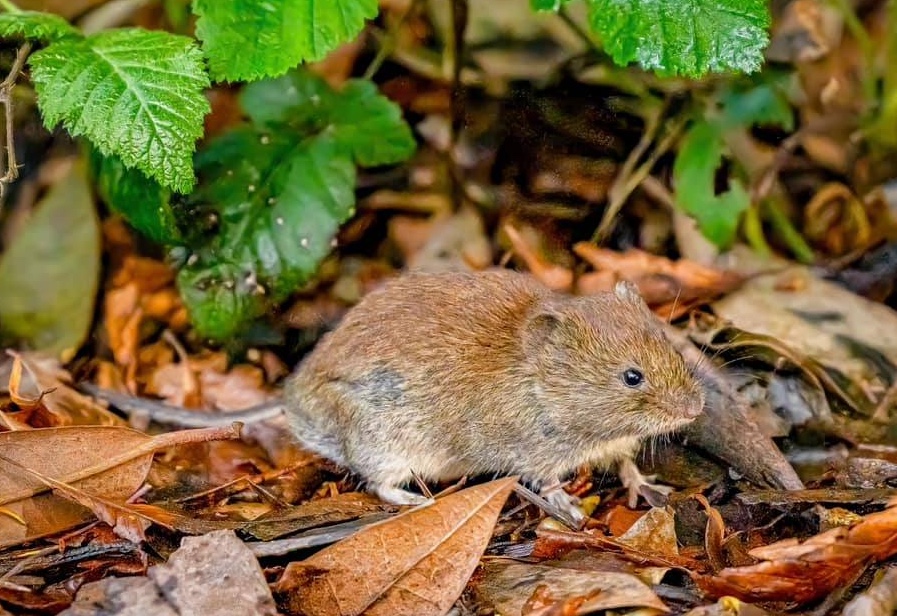Voles! Those mice-looking tiny rodents with shorter tails can turn your beautiful garden into an unpleasant mess of chewed roots and disrupted greenery. Their underground tunnels and voracious appetite for plants, roots, and bulbs make them unwelcomed guests in your home.
Therefore, the only step you should take when you find them in your yard or garden is to eliminate them. There are many natural ways you can use to get rid of voles in your yard and reclaim your sanctuary without resorting to extreme measures or disrupting nature’s delicate balance.
Without much ado, let’s dive in and learn how to get rid of voles in your yard or garden naturally.
Signs That You Have Voles in Your Yard Or Garden
Here are some common signs of vole infestation.
a) Surface Runways and Trails
Voles create shallow (about 1 to 2 inches wide), visible pathways that are often connected to burrow openings in grass or mulch as they travel in search of food.
b) Gnawed or Damaged Plants
Look for plants with gnaw marks near the base or close to the ground.
c) Visible Burrow Openings
Voles create burrow systems with multiple openings, usually around 1 to 2 inches in diameter. These openings lead to underground tunnels where voles nest and seek shelter.
d) Hollowed-Out Fruit or Vegetables
Voles may gnaw on the exterior or hollow out the insides of fruits, vegetables, or bulbs, especially during winter when food sources are scarce.
e) Voles Droppings
Vole droppings are black or dark brown, resemble small, pellet-like feces, and can be found along runways or near feeding areas.
f) Feeding Patterns
Voles often consume plants close to the ground, leaving a characteristic 45-degree angled cut on stems or vegetation.
g) Active Nests
Look for vole nests hidden in grass, mulch, or vegetation.
Related Posts:
- How To Repel Snakes From Your Yard
- How To Get Rid Of Gophers With Castor Oil And Dish Soap
- How To Get Rid of Moles In Yard and Garden
How To Get Rid Of Voles In Your Yard Or Garden Naturally
1. Habitat Modification
There are a couple of things to do to make your yard or garden less conducive for voles.
a) Keep Vegetation Short
How dense and tall is the vegetation in your garden? Dense plants and tall grasses provide perfect hiding places for voles. So, mow your lawn frequently to minimize hiding spots and make your garden less hospitable to these rodents.
In addition, trim back overgrown bushes, shrubs, and branches that touch the ground because voles use these as pathways and cover for their movements. Keeping vegetation trimmed and away from the ground minimizes the opportunities for voles to establish pathways in your yard.
b) Clearing Debris
Remove clutter and debris from your yard since voles often seek shelter in piles of leaves, wood, or debris. Clearing these areas eliminates hiding spots and discourages them from taking residence in your yard.
c) Mulch Carefully
Avoid placing thick mulch layers directly against the base of trees or plants, as it can offer voles with cover while feeding on roots or bulbs. Instead, leave a gap between the mulch and the base of plants to reduce the likelihood of voles nesting there.
d) Reduce Water Sources
Voles love areas with moisture in abundance. To counter this, avoid overwatering your lawn or garden beds, as this can create damp environments that attract these rodents. Instead, water deeply and sparingly to aid deeper root growth and prevent surface soil from staying constantly wet.
Opt for controlled and targeted irrigation methods like soaker hoses. Ensure proper drainage to prevent water accumulation. Also, regularly inspect and promptly repair any leaky irrigation systems, hoses, or pipes.
If you use rain barrels or collect water for gardening purposes, properly seal and maintain the containers. Regularly check for leaks or areas where water might accumulate, as these spots can inadvertently attract voles.
Read More:
2. Use Natural Predators
Manage vole numbers by encouraging predators like birds of prey, snakes, and carnivorous mammals to frequent your property.
a) Birds of Prey
Owls and Hawks are voracious hunters of small rodents, including voles. You can attract them by installing owl boxes or perches in your yard.
b) Snakes
Garter Snakes are non-venomous snakes that feed on voles and can help control their population. Leave areas of your yard untouched or create rock piles or brush piles to provide suitable habitats for snakes.
d) Carnivorous Mammals
Both foxes and outdoor cats are other natural predators of voles. Encourage foxes by allowing natural habitat areas to remain untouched. If you have a cat, allowing it access to your yard can help control vole populations.
Note
Refrain from using chemical pesticides in your yard, as they can harm natural predators. Additionally, embrace some level of natural wildlife in your garden because it can encourage the presence of predators that naturally regulate vole populations.
3. Utilize Plant Barriers
Voles feed on a majority of plants, but there are a few that they find distasteful due to their strong scents, tastes, or toxic properties. These include:
- Daffodils (Narcissus): These spring-blooming flowers contain alkaloids that voles find unappealing.
- Crown Imperials (Fritillaria): This ornamental plant has a distinctive smell that repels voles.
- Euphorbias: Some species of Euphorbia (such as spurge) have a milky sap that is toxic and unpalatable to voles.
- Alliums (Onion Family): Plants like garlic, onions have strong scents that repel voles. Voles tend to avoid most of the allium family plants.
Incorporate vole-repellent plants strategically around the perimeter of gardens, flower beds, or areas where voles are active. This creates a protective ring of plants voles avoid.
Also, intermingling vole-repellent plants with other vegetation not only creates a barrier but also adds aesthetic value to your garden. Consider planting in raised beds with hardware cloth or wire mesh at the bottom to prevent voles from accessing plant roots from below.
4. Exclude Them
A sturdy physical barrier effectively keeps voles from accessing specific areas of your yard or garden. Install barriers made of hardware cloth or wire mesh around your garden beds or valuable plant areas. Bury these materials at least 6 inches deep and extend them above the ground by several inches to prevent voles from burrowing underneath.
In addition, consider growing your plants in raised gardens to make it harder for voles to reach roots and bulbs. If planting in pots or containers, line the bottoms with wire mesh before adding soil to keep voles from accessing the plants from below.
Note
Ensure no vegetation or debris is leaning against the barriers because voles can use them as a bridge to bypass the exclusion methods.
5. Use Castor Oil Repellent
The strong scent and taste of castor oil that voles find unpleasant will encourage them to seek alternative locations. Apart from being an effective vole repellent, castor oil solution is also eco-friendly and easy to make.
Mix 1 part castor oil with 2 parts water, then add a small amount of liquid dish soap to help the solution adhere to plants and soil. Use a garden sprayer to apply the castor oil solution to areas where voles are active. Focus on the perimeter of gardens, flower beds, or areas where you’ve observed vole activity.
Ensure an even distribution of the solution across the targeted areas but concentrate on the areas where voles are most active or where plants are most vulnerable.
6. Use Live Traps
For an effective and humane method to control vole populations in your yard, try live traps since they don’t involve killing the animal. Choose live traps specifically designed for small rodents like voles, and ensure the traps you pick are appropriately sized to capture voles without harming them.
Besides getting the right size and type, pick well-made traps that are sturdy and durable for multiple uses. Set your live traps along runways, burrow entrances, or areas where voles are actively feeding or causing damage, placing them perpendicular to runways for better effectiveness.
Bait the voles with peanut butter, apple slices, or seeds. Once you’ve captured voles, take them at least a few miles away from your property for release, then release them in a location suitable for their survival.
7. Try Hot Pepper Spray
The strong scent and taste of capsaicin can discourage voles from feeding on plants.
Ingredients
- Hot peppers (e.g., jalapeños, habaneros, cayenne)
- Water
- Liquid dish soap
Recipe
- Chop or blend a handful of hot peppers (including seeds for more potency).
- Place the chopped peppers in a container with boiling water then cover it.
- Leave the mixture soaking for a day then filter it into a sizeable spray bottle.
- Next, add liquid dish soap to make sure the spray adheres to your plants.
Application
Apply the hot pepper solution to vulnerable plants, flower beds, or areas where voles are active. Ensure thorough coverage and focus on areas with vole tunnels, runways, or where voles have damaged vegetation.
Reapply the hot pepper spray after rainfall or every couple of weeks to keep it effective.
Note
Wear gloves when handling hot peppers to prevent skin irritation. Additionally, don’t let your pets or kids access the spray.
Conclusion
You don’t need harmful chemicals or extreme measures to have a vole-free yard. You can keep these rodents at bay with any of the above-discussed natural methods or a combination, and keep in mind that persistence and regular maintenance are crucial.

I’m Mike Hyle, an exterminator with 7+ years of experience handling all sorts of pests, including mice, cockroaches, bed bugs, and termites. I also write for Pest Solutions DIY blog to share my knowledge and help homeowners keep their homes pest-free. Outside work, I enjoy hunting, snowshoeing, and exploring nature. Check out my blog for helpful pest control tips!


